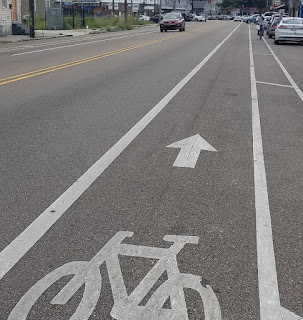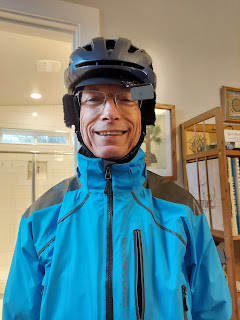Reality-based bicycling recommendations; The Idaho Stop
If you travel regularly as I do in New Orleans on St. Bernard street, between N. Claiborne Ave. and the intersection of N. Rampart and St. Claude Ave., you are bound to encounter what in the Pacific Northwest are referred to as "salmon". These bike riders are riding in the wrong direction, against the flow of traffic. The fish swim upstream in the fall to spawn, the human "salmon" ride upstream for unclear reasons. This is dangerous human behavior for several reasons, among them being that it may force another cyclist riding in the other direction to ride too close to a parked car (risking being doored) or to veer into the lane of traffic, risking being hit by a car. I think most likely the salmon riding behavior results from the rider feeling personally safer when they can "see what's coming" since virtually all bike riders in the city eschew the use of rear view mirrors. This "wrong way biking" is ubiquitous all over New Orleans, and is more common than in some other cities due to the preponderance of one-way narrow streets in the neighborhoods. Still, it's one of the most dangerous bicycling behaviors, accounting for 25% of all bike/car crashes in one Boulder study.
 |
| Looking river-ward on St. Bernard, in NOLA |
And that's just one of the bicycling behaviors that are currently illegal in New Orleans and that are so common I was stunned when I first started cycling regularly here several years ago. Let's just say that wrong-way riding is wrong, so don't do it. Maybe someone would want to mount an argument in favor, but I don't think they would win the debate. If you do this to save time, to take a short cut, whatever, I think you should consider it to be in the same category as driving while intoxicated. Maybe also the same as biking while intoxicated, but let's save that for another debate. What I want to focus on is another behavior that just about all cyclists do and which is also illegal in New Orleans (but not everywhere): rolling through stop lights.
At first, to me this seemed egregious and just plain wrong, since in my previous home community (Tacoma, WA), I virtually always obeyed the stop lights, except when there were no cars in sight anywhere. Regarding stop signs, I admit that I have always treated stop signs as a yield, never coming to a full stop and putting my foot down unless I had to to yield to cars or pedestrians. To me this clearly seemed safe, and became part of my routine. But cycling through the stoplight while the motorists have to wait? I think part of why cyclists running red lights seemed to me so disturbing in New Orleans is that there are so many more cyclists here compared to Tacoma. It's happening all the time, and waiting at the light while everyone else is riding through at times left me feeling a bit silly. Despite the appearance of this being normative behavior, I stubbornly held to my opinion, and vowed to remain in the distinct minority of bicyclists following the rule, waiting at stoplights until they turn green. I wanted to be a "good cycling citizen advocate" and demonstrate to motorists that we cyclists follow the rules. The last thing I want to do is behave in a way that will anger motorists and cause them to act aggressively toward cyclists or to be less likely to support measures to increase bicycling in our city ("those damn lawless, selfish bikers...").
A couple months ago I came across the 10th anniversary edition of a book called The Chainbreaker Bike Book. Written in 2008 by former New Orleans residents Shelley Lynn Jackson and Ethan Clark, it's subtitled An Illustrated Manual of Radical Bicycle Maintenance, Culture, & History. I highly recommend it especially for folks who run older bikes and want to keep them going smoothly for a long time or who want to build up a functioning machine from old parts lying around the shop. Shelley includes in the book copies of the Chainbreaker zines (small self-published homemade magazines) that she published in New Orleans from 2001-2005. In one of them, there is an article called Don't Get Hit! It is a set of 11 safety rules "to help you get by". Rule number 9 is as follows:
"Break the rules when it feels safer: now I don't mean to tell you to ride crazy. Ride safe, but if you come to a stop light and the road is clear, by all means, cross the road! It puts you ahead of the traffic and in a safer position. Cross the road safe, use your common sense."
This really got me thinking. Here's a very straight-forward piece of advice that makes a ton of sense, coming from a writer who seems very thoughtful and street-wise in a bicycling way. Since reading this, I have changed my behavior. In addition to breaking the law at stop signs like I have always done (treating them as yield signs instead), I now treat stop lights as stop signs: stopping, scanning for cars and pedestrians, and proceeding when it's safe to do so even if the light is still red. That's illegal, but arguably safer (see references below). Just one argument for it being safer is that it puts me across the intersection ahead of the cars that are lining up to go, so that we are not in the intersection at the same time. As I have researched this issue I have been influenced by the argument that rules created to control the flow of cars do not necessarily apply as well to bikes. And yet there is still debate. Except for Idaho, where it is legal while biking to treat a stop sign as a yield sign and a stop light as a stop sign (The Idaho Stop), we who live elsewhere are breaking the law with this behavior. Indeed, if you want to look at it that way, 90+ percent of bike riders in New Orleans are law-breaking rascals, since we are riding in a state that is not Idaho.
Even though I now follow the Idaho rules as explained above (as do the vast majority of cyclists in New Orleans), I realize that many motorists will object to our law-breaking and consider us perhaps less worthy of respect and consideration. This issue continues to bother me because I in no way want to increase the antagonism that might exist between motorists and cyclists. As the body-painted sign on the back of a World Naked Bike Ride participant last Saturday said: "You Dent, I Die". The stakes are high, and we need to be vigilant and alert as we navigate the city. Here are two resources that discuss the pros and cons of The Idaho Stop. For now, while riding in New Orleans, we're living in our own private Idahos.
Information on the Idaho Stop, pro and con:
Information on the Idaho Stop, pro and con:



Comments
Post a Comment